Looking in my library I found an old text written by the late Mrs. Frances Sefton in mid 70’s years, Mrs. F. Sefton was a Lhasa Apso breeder “Cheska Kennels” and judge from England and who later moved to Australia.
Frances Sefton was a person with an eye for a dog… she had the talent to see a dog in all his details and the capability to express this in word and paper.
extract from her story….
keywords: breed type, Lhasa apso, characteristics, quality, type and expression 🙂
Breed type is a phrase used frequently and if I may say so, somewhat loosely. What exactly does it mean?
The dictionary defines type as – kind, category, constituents which share similar characteristics – and – particular group. The word characteristics is defined as distinguishing quality. The word quality is also frequeently used in critiques and in discussions on a dog individual attributes.
The Lhasa Apso breed type is a product of nateral selection AND human selection. Certain characteristics which are part of the breed type evolved as a result of geographical and climatic environment – the high attitudes, the dry windy climate, the dusty terrain, the sort hot summer and the long bitterly cold winter of the Himalaya region. Among these are head features, the coat, eye-fall, the musculation and body structure, the general hardness and longevity of the breed.
Other characteristics were the result of man’s selection for this visual preferendces, such as size, color, the pattern of coat growth, and for function, such as terperament and sharpness of hearing.
A written description of the breed type…
The written description of type is in the breed standard ( not the same worldwide ed) and accepted by the official canine clubs, breed clubs and used by breeders, exhibitors and judges, as a guide! Breed standards, because they are written by humans, are full of imperfections, but they are an attempt to set a word picture of the breed of dog. Breed standards are not rigid document, and are revised from time to time, hopefully to clarify the meaning, but unfortunately all too often to change it because the breed has changed (….) over the years.
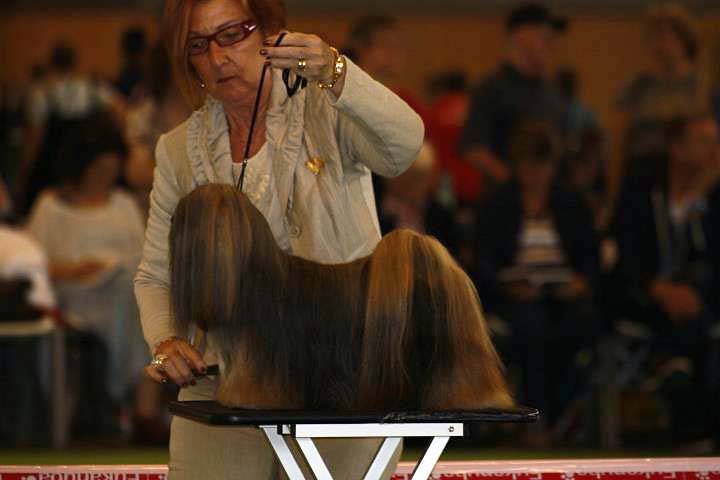
The Lhasa Apso comes from Tibet, but the Tibetans never wrote a breed standard, the Indians, the British, the Americans who went to Tibet and took home dogs learned first hand what the Tibetans wanted in their dogs, and they went home and wrote down the first standards for our breed. The standard we use today is intrinsically the same as that was written in when a group of interested people sorted out what they realised were four separated breeds – Tibetan Terrier, Tibetan Spaniel, Lhasa Apso and the Chinese cousin the Shih Tzu.
Defining Breed Type from the Standard
Sentences and phrases which deal specifically with the breed characteristicts suggest ways of recognising visually the breed type. There is only one breed type. To use the phrase “he is not my type” is misleading. In fact, to be diplomatic, they should use the usual phrase of English judges in their critiques – “I preferred the other one”!
The major characteristicts of the Lhasa Apso which, put together, give you a dog that looks like a Lhasa Apso and no other breed involve the following factors:
- Size
- Musculation
- Balance
- Gait
- Head and Expression
- Coat
- Temperament
- Tail
My comments, (Frances Sefton ed) although based on the breed standard, will also contain personal opinions from nearly 25 years of associations with the breed. The Lhasa Apso is suprisingly normal in construction under the coat. There are no exaggerations of limb as there are in its associated breeds, such as the Shih Tzu’s shortened limbs and a deep chest, the Tibetan Spaniel’s slightly bowed forelegs, and the Tibetan Terrier’s extra lenght of foreleg and thin bones.
SIZE
The Lhasa Apso is a small dog – ideally 10 inches says the standard. Not a medium size (15-20 inches) not a large dog. There is no weight clause. However the Lhasa Apso is not flimsy dog, because the standard also makes reference such as: neck: strong….strong loin…., hindquaters well developed with good muscle… There is also the controversal word “solid”that was added in the 1970 revision.
I personally disagreed with its inclusion because of the danger of misinterpretation, but a dictionary definition is : firm, strong, compact and that is my interpretation of it. The height then cannot be taken out of the context for breed type. A height within a range of 9 to 11 inches is acceptable provided the other attributes are present and is better than a 10 inch dog which achieves that ideal height by sortened upper arm and deep-slung chest or one that is shelly and flimsy.
MUSCULATION
References in the standard to good muscle are too brief in my opinion. In fact the Lhasa Apso has extraordinarily good muscle. The promise of dense muscle can be seen even in a baby puppy, and I believe that it is a key to correct type. Hold a baby puppy up under the chest, then viewing from the rear, lift the hindquarters by the tail. The pup should tense the muscles and stretch the back. Of course muscles takes time to develop, and Lhasas are not early maturing breed. The reason for well muscled hindquarters is because of the dog’s remarkable agility in leaping, spinning and changing course. The strong muscle in the loin also is an aid to agility.
BALANCE
The standard uses the word well-balanced and also requires that the lenght from point of shoulders to point of buttocks is greater than height at the withers. In fact this is pretty well the balance of a “normally” constructed dog, but it is a breed characteristic. When standing free the hind hocks should fall naturally under the rump, not extended back beyond. I am not going to give specific measurements, I will just say that when a dog is stood with head up and tail curled over, it will look shorter in back, and when the same dog moves it will look a little longer. If it looks long when stacked it’ll look even longer when it moves.
Head carriage and tail carriage contribute to the balance to the dog. Heads are carried on necks – a good strong neck which is carried on well-laid but not over-angulated shoulders will give good balance. A neck can look short and stuffy if the hair over the neck, the dense man referred to the standard, is thick, but the hands will pick the smooth flow. Upright shoulders will give a “ewe”neck, stuck on upright like a giraffe – it looks long, but it isn’t and again the hands will tell if the eye can’t!
The standard says the dog is well ribbed up which means a long rib cage extended well back. It does not mean a rounded barrel rib cage. The coupling (loin) is not long, the length of back is in fact in the rib cage, but the standard also requires the dog to be compact which means that thought the body is longer than the height, the Lhasa Apso is not long-bodied dog.
Good balance is required at the tail end, the tail is high set, which means that the Lhasa Apso does not have a “sloping croup”- in other words the angle of the pelvis is not great. The tail is curled over the back and contributes to the correct balance of the dog as a whole.
GAIT
On this website you will find a general article from Frank about movements of the dog, now we provide you know how about the Lhasa Apso gait;
Frances continue: if I had to pick a controversial characteristic of the Lhasa Apso it would be the gait. Furore has raged over the last few years, mainly about the so-called “Shih-Tzu” behind. There are, particularly in the USA, many Lhasas with an exaggerated hind action, which is untypical and which is not, as it claimed to be, good hindquarters drive. Why do some Lhasa Apsos move with an exaggerated hindquarter kick? In the extreme case because the shoulder is upright, the pelvis is tipped forward till it’s almost flat. The standard discribes free and jaunty in movement and that is the only reference in the current standard we have to gait! However can deduce from, the near normal construction of the Lhasa Apso that the natural gait of the dog is a trot, what you would expect from a dog efficient as the Lhasa.
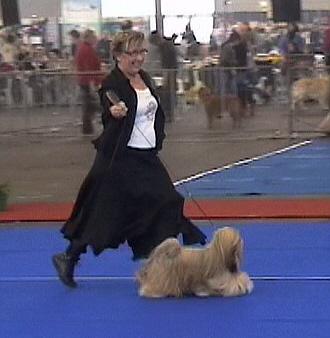
The trot as for the Lhasa Apso; with a correctly laid sbhoulder, there will be sufficient forward reach for the front paw to come down under the dogs nose. The power is carried through the loin, and propulsion through the hindquarters carries the body forward efficiently, freely and easily and with true drive.
The rear pads are revealed briefly, in a full coated dog usually seen only as a curving up the skirts!
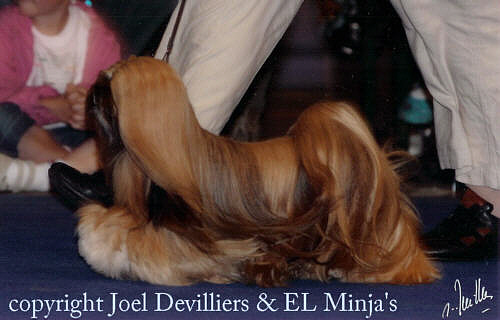
HEAD AND EXPRESSION
In this area the Lhasa is not quite the same as a “normal”canin. The head of the Lhasa Apso is an intermediate type of head between the short faced and normal long head. The skull is not broad nor flat. There is a definite occiput. Confusion often arises over the phrase falling away behind the eyes this means that there are no bony ridges over the eyes, nor the slight doming of the Tibetan Spaniel and the zygomatic arch is not prominent as in the Tibetan Terrier.
In profile the head proportions are one third muzzle to two thirds skull. The foreface is straight with a medium stop, so that in profile there is no dishing of the muzzle nor downface. One particular point which is not in the standard is the tip of the nose leather; this is quite distinctly pointed and does not drop at all. If it is flat, or pushed back, it is untypical.
In fact the muzzle has depth, but as the standard says not square. The muzzle does not taper from the eyes but comes out at the same width from the eyes to the nose and viewed front on, or felt with the hands, is a vertical rectangle, which in profile gives the appearance of bluntness or being chopped off.

The ears: are pendant, set about the level with the eyes. On a broad skull they tend to be higher set! but this must be assessed according to the effect on expression.
Dark eyes; a slightly lighter colour often accompanies some Golds or grey. Medium in size, set frontally and the best way to describe their shape is to say they are like almond shape eyes or like human eyes. It’s important the eyes are not prominent or full, not small and deep set. The Lhasa Apso expression is not soft and soulful, but is watchful though not sharp.
The Bite: The ideal bite is fully decribed. The true scissor bite, with the upper incisors fitting closely over the lower, and set in a curve, is untypical, as it give the wrong expression, with a lack of underjaw. The so-called reverse scissor bite has a slight flarness of the contre incisors and this is a very important feature. There is always has been a great variation in bite ( and always will be ed. Frank) and the acceptability of any bite, alignment of teeth or missing teeth depends very much on its effect on expression. A slightly less then perfect bite can still provide the correct expression. A weak underjaw, down face, dish face, lack of lower lip, are wrong.
Coat
It is a characteristic of the Lhasa Apso breed that the coat is all encompassing. It grows every were on the dog. The Lhasa Apso has long eye-lashes like a cow! These serve to hold the fall of hair over the eyes away from the eyes. The eye-fal served as a protection in the windy dusty environment of Tibet. The coat is of good length – this is generally accepted as being floor-length, though this is not a trimmed breed the coat is often trimmed to floor length because too much length of coat trailing the floor can impede the free and jaunty movement and it is also for that reason that excessive length of hair on the feet is also trimmed back.
The coat is a double coat; the outer jacket is hard, but not coarse, more like human hair. Nowadays most coats are straight but yeats ago there were a lot of frizzy coats. There seems to be an increase in the number of soft, fine coats. Silky texture hair is also not desired.
The undercoat is densest in cold climates and certainly is thinner in hot weather. The undercoat is fine and soft, but should not be short and cotton-wooly. In the mature adult it should be quite long perhaps three or four inches (7.5-10 cm).
The texture of the coat is an important characterictic and the standard also says it is heavy which anyone who has spun it will conform. If you could weigh a dog in full coat, then clip it off completely and re-weigh it, you would be surprised at the difference.
TEMPERAMENT
This is an important characteristic. The temperament of the Lhasa Apso is unique. To know the Lhasa you have to live with them. Gay and assertive, but [chary] aloof with strangers. The chary or aloof with strangers comes from their function as an indoor alarm dog. They are extremely sharp of hearing, and adept at analyzing human character. Lhasas quickly pick up the vibrations in the atmosphere. They can be gay and assertive not just at home but also in the showring. Lhasa are very stubborn, wilful, cunning and would rather die than give in. And they never forget, sensible socialising and being aware of the normal trauma periods in any dogs development to maturity are especially important with Lhasa Apsos.
TAIL
The concern of this characteristic; here the type and the set of tail, – high set, carried well over the back -.
Well furnished with long hair, the kink, if is there, is right at the tip and is like a broken-joint. The kink is disappearing from the breed. Fault is a low set tail, loose gay tails.
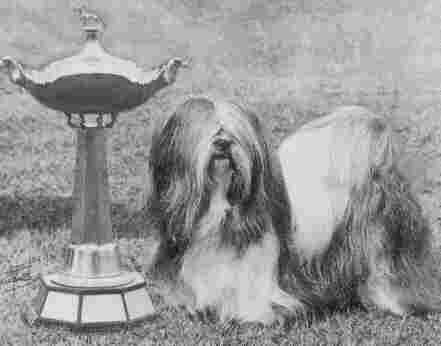
Eng Ch Cheska Alexander of Sternoc pictured as a youngster when he finished his Championshioo at 16 months.
He was bred/owned by Frances Sefton an co-owned in England by Pamela Cross-Stern.
The way to success:
Quality! a dog with quality is healthy and sound in body and mind….!
The dogs used for reproduction must have a good bite, is not cow-hocked or unsound behind, is not out of elbow. Well muscled with firm bone, compact body good coat and possible to have a good placement in the Dogshow ring. A dog with quality glows with health and condition – catches the eye of the judge.
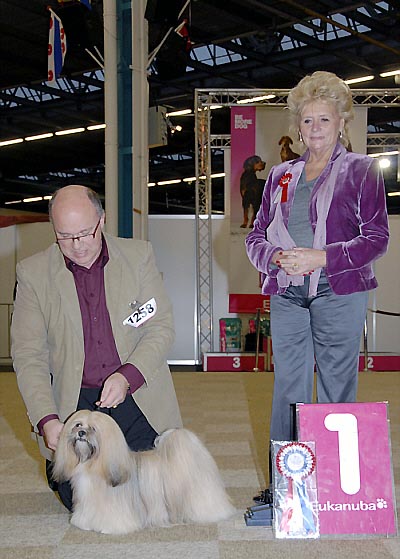
Note from Frank:
As Breeders we can breed Lhasa Apsos the way we wish. But we have to breed quality healthy Lhasa Apso dogs as these pups born today are the foundation for the future!
Second best is not good enough! Do not breed with shy or aggressive Lhasas wich happen to often these days, not for the show and not for pets!
What we put in we will get out.
By Frank van Tatenhove
